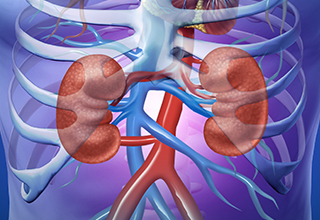Program Description

Kidneys are vital organs that help maintain stable composition of the blood. They prevent waste, toxins, and extra fluid from building up by filtering all the blood in the body every 30 minutes. They also regulate levels of electrolytes, make important hormones that control blood pressure, make red blood cells, and keep bones strong.
Individuals with diseased or damaged kidneys, have a higher risk of some health outcomes such as heart disease, stroke, anemia, or increased occurrence of infections.
More than one in seven U.S. adults are estimated to have chronic kidney disease (CKD). Common risk factors for CKD are hypertension, heart disease, infections, and diabetes, though genetics and family history can also play a role. However, these risk factors do not explain all cases of CKD.
What Is NIEHS Doing?
NIEHS-funded researchers are studying how environmental exposures in combination with other factors may affect kidney disease in the U.S. and around the world. Some are working to understand the underlying cellular mechanisms that lead to kidney disease and its progression. Others are following individuals over time, evaluating the potential risk factors associated with developing CKD. Researchers are also documenting how certain chemicals affect kidney function.
A unique epidemic of chronic kidney disease is occurring in specific regions of the world that cannot be explained by traditional or known risk factors. This disease is commonly referred to as chronic kidney disease of uncertain etiology (CKDu), but it is also known as Mesoamerican Nephropathy (MeN), CKD of non-traditional etiology (CKDnt), chronic agricultural nephropathy CAN), and CKD with multifactorial origin (CKD-mfo). NIEHS funds research to understand how environmental factors, genetics, and other factors are involved in CKDu.
In collaboration with other health organizations, NIEHS-supported international workshops to bring experts together to discuss current knowledge and limitations in our understanding of CKDu. In 2021, NIEHS, the National Institute of Diabetes and Digestive and Kidney Diseases, and the Fogarty International Center launched a collaborative effort to support the CKDu in Agricultural Communities (CURE) Research Consortium.
Highlighted projects funded by NIEHS:
Cadmium Exposure and Chronic Kidney Disease in a Rural Population
Scientists are studying the association between metals, particularly cadmium, and chronic kidney disease. This study builds on an existing study, evaluating exposure and disease outcomes over 15 years.
Cohort Follow-up Study of Children Exposed to Arsenic in Utero and Early Childhood
Researchers are studying children exposed to arsenic early in development to identify biological markers of early life effects on kidneys, in addition to other important health outcomes.
Etiologic and Mechanistic Factors Underlying Chronic Kidney Disease in Guatemalan Sugarcane Workers
Researchers are studying agricultural workers in Guatemala to identify occupational, environmental, and lifestyle factors that place them at risk for developing CKDu. They are also working to understand the underlying biological mechanisms by which dehydration may contribute to CKDu risk in addition to exposure to chemicals that are known to harm the kidneys.
A unique epidemic of CKDu disproportionately affects young male agricultural workers in El Salvador. Researchers are investigating the role of exposure to herbicides, metals, and heat stress on the risk of CKDu. This project also aims to identify biological markers of kidney injury that may be useful for early detection and treatment of kidney injury.
Occupational Heat Exposure and Gene-Environment Interactions in Mesoamerican Nephropathy
Researchers are examining occupational heat exposure in a group of agricultural and non-agricultural workers. They are investigating the relationships between heat and both kidney injury and kidney function and testing for potential interactions between underlying genetics and environment exposures. The findings will help identify individuals who are most at risk for the disease, which will inform strategies to prevent new cases.
Role of SMOC2 in Kidney Fibrosis
Kidney fibrosis occurs when excess fiber-like connective tissue spreads over and through the kidneys, which can lead to scarring and ultimately renal failure. Scientists are studying how a gene found to be critically involved in kidney fibrosis, called SMOC2, regulates the initiation and progression of the disease. They are further investigating whether genetic or pharmacological therapies that target SMOC2 can improve health outcomes.
For additional information on what NIEHS grantees are doing, see the Kidney Disease Grantees webpage.
Program Contacts




